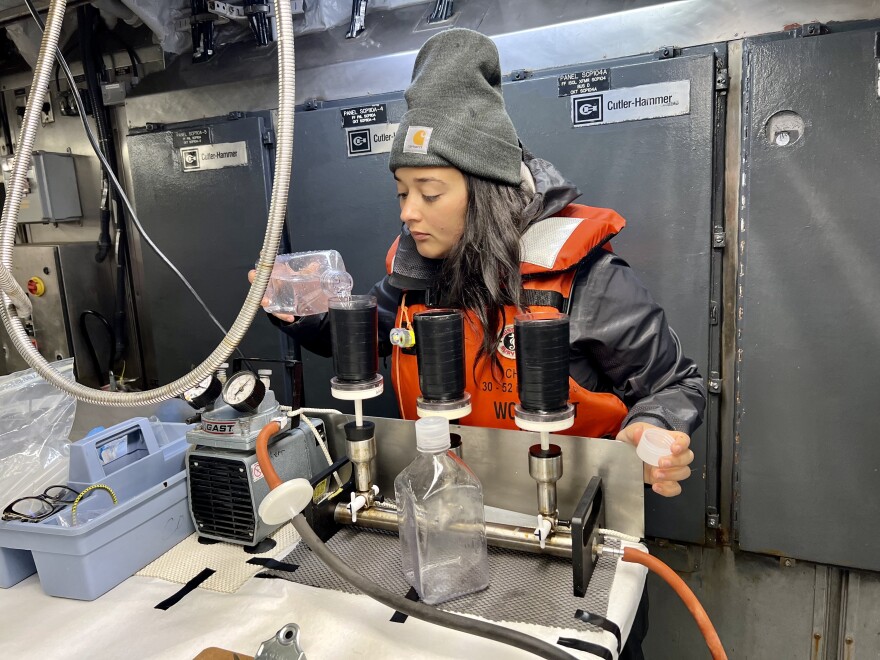The seawater in 24 plastic Nalgene bottles sloshed gently in the wet lab on the Bell M. Shimada, one of the National Oceanic and Atmospheric Administration’s ocean research vessels.
Each bottle contained phytoplankton, which are microalgae that serve as food for organisms that feed young salmon and other fish in the ocean.
These phytoplankton are the first link in the oceanic food web and are easier to sample and study than larger species, like fish and marine mammals.
But, for a long time scientists missed a step in the ocean’s food web. Scientists didn’t include the organisms that graze on phytoplankton, said Rebecca Smoak, an Oregon State University graduate researcher.
“We were missing this step in the trophic cascade that has a lot of influences,” Smoak said of microzooplankton grazers that eat phytoplankton.
While the step is essential, early scientists missed it, she said.
That’s why Smoak and graduate researcher Aliya Jamil also monitored microzooplankton grazers in each of these plastic Nalgene bottles. During this experiment, the scientists watched how the phytoplankton grew in the bottles and how much phytoplankton the grazers, or microzooplankton, ate.
This study, which took place May 6-17, was part of a larger survey of the Northern California Current ecosystem. During the survey, scientists hoped to learn more about ocean conditions and how those conditions affect the ocean’s food web, from phytoplankton to microzooplankton to zooplankton to fish to marine mammals.
It’s important to know what’s happening to phytoplankton, said Maria Kavanaugh, an assistant professor at OSU’s College of Earth, Ocean and Atmospheric Sciences.
In addition, phytoplankton’s key role in the oceanic food web, phytoplankton also play a key role in the ocean’s ecosystem. Phytoplankton reproduce and react quickly to changes in their environment, including variations in ocean temperature, which could warm up even more as the climate changes, Kavanaugh said.
To learn more about phytoplankton while on the Shimada, scientists set up an incubator to grow the tiny organisms.

First, scientists filtered 14-liters of sea water each morning, a process that could take up to three hours. Then, scientists added phytoplankton to the plastic bottles, which had specially made lids that allowed for an exchange of carbon dioxide and oxygen so that photosynthesis could occur. During photosynthesis, phytoplankton consume carbon dioxide and release oxygen.
In each bottle, the scientists diluted the number of phytoplankton and microzooplankton grazers. In addition, they added different amounts of nutrients to the bottles. The number of grazers in each bottle varied the chances the phytoplankton would become a meal.
Then, scientists matched data from this dilution experiment with information gathered from a complex microscope called an imaging flow cytometer. The cytometer allowed scientists to measure how well different species of phytoplankton grew in different environments.
The growth of these tiny organisms could have a big effect on systems in the ocean, Kavanaugh said.
“Because they are so tiny, they have evolved to respond rapidly to changes. They almost are like the first early warning of things to come,” Kavanaugh said.
Phytoplankton grow quickly and respond to changes over weeks or seasons, she said, whereas salmon and other fish might take longer to display the stresses caused by climate change.

“By watching things happen at very small and rapid scales, we can help inform the longer term trends,” Kavanaugh said.
For this experiment on the Shimada, scientists observed the rapid trends over 24 hours.
Scientists placed the bottles into a specially built incubator, secured on the back deck of the ship.
As the ship rocked and waves crashed onto the deck, Smoak, Kavanaugh and Jamil carefully placed each bottle into the incubator.
Here, the phytoplankton got enough sunlight to grow. A pump circulated seawater through the incubator to regulate its temperature.
“Good morning plankton babies,” Smoak said the day after diluting the phytoplankton in the bottles, singing “Baby plankton in the deep blue sea,” her version of a Raffi tune called “Baby Beluga.”
After one day, scientists removed the bottles from the incubator and repeated the experiment in different parts of the ocean.
The scientists would later track how much phytoplankton that grazers ate. When the grazers eat, it could be a scene out of the movie “Alien,” Smoak said.
“Sometimes they engulf phytoplankton whole,” she said. “One grazer can actually open its entire stomach vacuole. Imagine just taking your stomach, opening it up, and chomping.”
However, there could be fewer phytoplankton to chomp on as ocean conditions warm because of climate change, which could be bad news for salmon and other fish, Kavanaugh said. Changing ocean temperatures could affect where phytoplankton bloom, she said, which could have cascading effects up the food chain.
“Climate will affect where fish are trying to forage and trying to find food,” Kavanaugh said. “The food becomes less abundant. The food webs become less efficient. Overall, there’s less food for fish.”
Moreover, fewer phytoplankton could speed up climate change, Kavanaugh said, explaining that phytoplankton contribute to a process called carbon cycling more than any other organism in the ocean.
Carbon cycling is a good thing for the ocean.
In this process. Phytoplankton absorb heat-trapping carbon dioxide during photosynthesis. Then, grazers eat the phytoplankton, or the phytoplankton sink to the bottom of the ocean, taking that excess carbon with them. Once the carbon sinks into deeper water or into sediments on the ocean floor, it can no longer contribute to climate change in the earth’s atmosphere, she said.
“That’s the ocean’s gift to us,” Kavanaugh said.
⬙
Read more in this series:
Part one: To unravel some of the ocean's mysteries, scientists head to sea
Part two: Watching for whales – and their food
Part four: This single-celled sea critter could help scientists learn about climate change
Part five: More than work: living on a ship, crew, officers become friends, family



